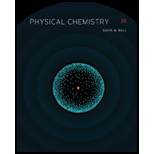
(a)
Interpretation:
The equilibrium concentration of all species if the initial concentration of
Concept introduction:
The static equilibrium is defined as a process in which the
(a)
Answer to Problem 5.63E
The concentration of
Explanation of Solution
The equilibrium constant of the reaction is
The given balanced
The equilibrium constant for the above reaction is expressed as,
Where,
•
•
•
The ICE table for the given reaction is expressed as,
Substitute the equilibrium concentrations of
Take square root on both sides.
Solve this quadratic equation by the formula,
Where,
•
•
•
Substitute the values of
The value of
Substitute the value of
The concentration of
(b)
Interpretation:
The equilibrium concentration of all species if the initial concentration of
Concept introduction:
The static equilibrium is defined as a process in which the rate of forward reaction or the rate of backward reaction is zero. On the other hand in dynamic equilibrium, the rate of forward and backward reaction is equal.
(b)
Answer to Problem 5.63E
The concentration of
Explanation of Solution
The equilibrium constant of the reaction is
The given balanced chemical reaction is,
The equilibrium constant for the above reaction is expressed as,
Where,
•
•
•
The ICE table for the given reaction is expressed as,
Substitute the equilibrium concentrations of
Take square root on both sides.
Solve this quadratic equation by the formula,
Where,
•
•
•
Substitute the values of
The value of
Substitute the value of
The concentration of
(c)
Interpretation:
The equilibrium concentration of all species if the initial concentration of
Concept introduction:
The static equilibrium is defined as a process in which the rate of forward reaction or the rate of backward reaction is zero. On the other hand in dynamic equilibrium, the rate of forward and backward reaction is equal.
(c)
Answer to Problem 5.63E
The concentration of
Explanation of Solution
The equilibrium constant of the reaction is
The given balanced chemical reaction is,
The equilibrium constant for the above reaction is expressed as,
Where,
•
•
•
The ICE table for the given reaction is expressed as,
Substitute the equilibrium concentrations of
Take square root on both sides.
Solve this quadratic equation by the formula,
Where,
•
•
•
Substitute the values of
The value of
Substitute the value of
The concentration of
Want to see more full solutions like this?
Chapter 5 Solutions
PHYSICAL CHEMISTRY-STUDENT SOLN.MAN.
- Provide the semi-developed formula of isooxazole obtained by reacting acetylacetone and hydroxylamine.arrow_forwardGiven a 1,3-dicarbonyl compound (R1-CO-CH2-CO-R2), indicate the formula of the compound obtaineda) if I add hydroxylamine (NH2OH) to give an isooxazole.b) if I add thiosemicarbazide (NH2-CO-NH-NH2) to give an isothiazole.arrow_forwardAn orange laser has a wavelength of 610 nm. What is the energy of this light?arrow_forward
- The molar absorptivity of a protein in water at 280 nm can be estimated within ~5-10% from its content of the amino acids tyrosine and tryptophan and from the number of disulfide linkages (R-S-S-R) between cysteine residues: Ε280 nm (M-1 cm-1) ≈ 5500 nTrp + 1490 nTyr + 125 nS-S where nTrp is the number of tryptophans, nTyr is the number of tyrosines, and nS-S is the number of disulfide linkages. The protein human serum transferrin has 678 amino acids including 8 tryptophans, 26 tyrosines, and 19 disulfide linkages. The molecular mass of the most dominant for is 79550. Predict the molar absorptivity of transferrin. Predict the absorbance of a solution that’s 1.000 g/L transferrin in a 1.000-cm-pathlength cuvet. Estimate the g/L of a transferrin solution with an absorbance of 1.50 at 280 nm.arrow_forwardIn GC, what order will the following molecules elute from the column? CH3OCH3, CH3CH2OH, C3H8, C4H10arrow_forwardBeer’s Law is A = εbc, where A is absorbance, ε is the molar absorptivity (which is specific to the compound and wavelength in the measurement), and c is concentration. The absorbance of a 2.31 × 10-5 M solution of a compound is 0.822 at a wavelength of 266 nm in a 1.00-cm cell. Calculate the molar absorptivity at 266 nm.arrow_forward
- How to calculate % of unknown solution using line of best fit y=0.1227x + 0.0292 (y=2.244)arrow_forwardGiven a 1,3-dicarbonyl compound, state the (condensed) formula of the compound obtaineda) if I add hydroxylamine (NH2OH) to give an isooxazole.b) if I add thiosemicarbazide (NH2-CO-NH-NH2) to give an isothiazole.arrow_forwardComplete the following acid-base reactions and predict the direction of equilibrium for each. Justify your prediction by citing pK values for the acid and conjugate acid in each equilibrium. (a) (b) NHs (c) O₂N NH NH OH H₁PO₁arrow_forward
- 23.34 Show how to convert each starting material into isobutylamine in good yield. ཅ ནད ཀྱི (b) Br OEt (c) (d) (e) (f) Harrow_forwardPlease help me Please use https://app.molview.com/ to draw this. I tried, but I couldn't figure out how to do it.arrow_forwardPropose a synthesis of 1-butanamine from the following: (a) a chloroalkane of three carbons (b) a chloroalkane of four carbonsarrow_forward
 Chemistry: The Molecular ScienceChemistryISBN:9781285199047Author:John W. Moore, Conrad L. StanitskiPublisher:Cengage Learning
Chemistry: The Molecular ScienceChemistryISBN:9781285199047Author:John W. Moore, Conrad L. StanitskiPublisher:Cengage Learning Chemistry: Principles and PracticeChemistryISBN:9780534420123Author:Daniel L. Reger, Scott R. Goode, David W. Ball, Edward MercerPublisher:Cengage Learning
Chemistry: Principles and PracticeChemistryISBN:9780534420123Author:Daniel L. Reger, Scott R. Goode, David W. Ball, Edward MercerPublisher:Cengage Learning Principles of Modern ChemistryChemistryISBN:9781305079113Author:David W. Oxtoby, H. Pat Gillis, Laurie J. ButlerPublisher:Cengage Learning
Principles of Modern ChemistryChemistryISBN:9781305079113Author:David W. Oxtoby, H. Pat Gillis, Laurie J. ButlerPublisher:Cengage Learning Chemistry by OpenStax (2015-05-04)ChemistryISBN:9781938168390Author:Klaus Theopold, Richard H Langley, Paul Flowers, William R. Robinson, Mark BlaserPublisher:OpenStax
Chemistry by OpenStax (2015-05-04)ChemistryISBN:9781938168390Author:Klaus Theopold, Richard H Langley, Paul Flowers, William R. Robinson, Mark BlaserPublisher:OpenStax Chemistry for Engineering StudentsChemistryISBN:9781337398909Author:Lawrence S. Brown, Tom HolmePublisher:Cengage Learning
Chemistry for Engineering StudentsChemistryISBN:9781337398909Author:Lawrence S. Brown, Tom HolmePublisher:Cengage Learning Chemistry: Principles and ReactionsChemistryISBN:9781305079373Author:William L. Masterton, Cecile N. HurleyPublisher:Cengage Learning
Chemistry: Principles and ReactionsChemistryISBN:9781305079373Author:William L. Masterton, Cecile N. HurleyPublisher:Cengage Learning





